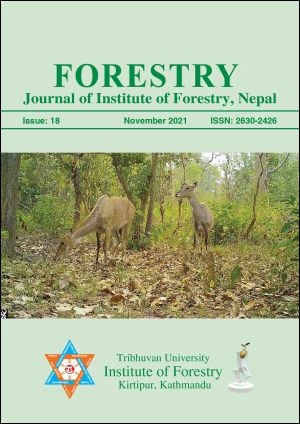Regeneration Status and Diversity under Irregular Shelterwood System: A Study from Panchkanya Community Forest, Sunsari, Nepal
DOI:
https://doi.org/10.3126/forestry.v18i01.41751Keywords:
Irregular shelterwood system, plant diversity, regeneration, Shorea robustaAbstract
The present study is the outcome of vegetation sampling conducted in the managed and unmanaged forest patch under the irregular shelterwood system to analyze community structure and plant diversity in a degraded mixed forest in eastern Terai, Nepal. Systematic random sampling was followed by laying out 15 quadrates sized 4m2 with uniform spacing of 50 meters in both managed and unmanaged blocks, respectively. This study revealed that the first and second-year regeneration felling subsisted the Shorea robusta in the managed forest patch. There was observed a remarkable increase in regeneration but a decrease in plant diversity in the managed area in comparison to the unmanaged one. Simpson’s index of diversity was 0.760 and 0.890 and Shannon-Wiener indexes were 1.82 and 2.43 in managed and unmanaged forest blocks, respectively. Independent sample t-test showed a significant difference in the total number of regenerations between managed and unmanaged forest blocks since P-value <0.05 (P=0.0166) i.e., managed blocks with opened canopy had higher regeneration but a lower diversity. This study concludes that the irregular shelterwood system is deemed pivotal for increased regeneration of Shorea robusta particularly in the eastern lowland of Nepal.
Downloads
Downloads
Published
How to Cite
Issue
Section
License
© Tribhuvan University, Institute of Forestry




